
👋🏼 This is part of series on concurrency, parallelism and asynchronous programming in Ruby. It’s a deep dive, so it’s divided into several parts:
- Your Ruby programs are always multi-threaded: Part 1
- Your Ruby programs are always multi-threaded: Part 2
- Consistent, request-local state
- Ruby methods are colorless
- The Thread API: Concurrent, colorless Ruby
- Bitmasks, Ruby Threads and Interrupts, oh my! (Concurrent, colorless Ruby)
- When good threads go bad: Concurrent, colorless Ruby
- Thread signal handling: Concurrent, colorless Ruby
- Thread and its MaNy friends: Concurrent, colorless Ruby
- Fibers: Concurrent, colorless Ruby
- Processes, Ractors and alternative runtimes: Parallel Ruby
- Scaling concurrency: Streaming Ruby
- Abstracted, concurrent Ruby
- Closing thoughts, kicking the tires and tangents
- How I dive into CRuby concurrency
You’re reading “Bitmasks, Threads and Interrupts, oh my!". I’ll update the links as each part is released, and include these links in each post.
- Interrupting Threads
Interrupting Threads 🧵
The Ruby thread scheduler is rude. There, I said it.
It’s always telling your threads how to run, when to run, how long they can run - it stops them whenever it wants and then tells other threads they have to start working. It’s bossy as hell. On top of that, it’s not even polite about it. It feels free to interrupt your threads - it decides when, and your threads have to just play along and listen.
But threads put up with it. They even benefit from it, if you can believe that. The thread scheduler may be abrupt, but it’s looking out for the runtime. If that’s the case - there must be a good reason… Why do threads put up with these scheduler shenanigans?
Managing threads 👷🏼♂️👷🏻♀️
An important purpose of a thread scheduler is efficiency and fairness. It manages what threads are running, for how long, and what context each thread gets loaded with.
In normal operation this comes down to a few things:
- Time sharing: every thread, under normal circumstances, gets roughly 100ms of CPU runtime1. Since only one thread can run Ruby code at a time2, this keeps a single thread from dominating the program3
- Blocking operations: certain operations will “block” a thread. Most forms of IO, and
sleep, for instance. When the thread blocks, the thread scheduler allows other threads to run - Priority: we can suggest a priority for our threads, and the thread scheduler will take it into consideration when choosing what to run next and for how long
- Passing control: we can suggest actions to the thread scheduler, like
passing control orstopping the current thread so other threads can take over - Locking: we can synchronize access to resources, and the thread scheduler chooses the order of access to the resource
How does it handle all this?
An important interruption
The scheduler isn’t a single object - it is the behavior produced by specific VM checks and functions which opt-in to thread scheduling behavior. In this post, we’ll focus on time sharing, priority, and interrupting threads - which are managed through a concept deeply woven into CRuby - a set of functions the VM calls at specific checkpoints.
In the CRuby runtime, this concept revolves around “interrupts”4. It contains a set of possible events that could “interrupt” the flow of a Ruby program in general, and different threads in particular. There are several interrupt events possible:
- Timer interrupt
- Trap interrupt
- Pending interrupt
- Terminate interrupt
- VM barrier interrupt
- Postponed job interrupt
In the CRuby internals, these are represented by an integer mask. If we took the C code and represented it in Ruby, it would look like this (each mask is a hex value):
TIMER_INTERRUPT_MASK = 0x01
PENDING_INTERRUPT_MASK = 0x02
POSTPONED_JOB_INTERRUPT_MASK = 0x04
TRAP_INTERRUPT_MASK = 0x08
TERMINATE_INTERRUPT_MASK = 0x10
VM_BARRIER_INTERRUPT_MASK = 0x20
Why integer masks?
What is an integer mask, and why would CRuby represent internal states this way?
📝 “mask” is a conventional name for a pattern to isolate specific bits. A “mask” sounds like something that would cover up something else (ie, a mask covering your face). In a sense, these serve a similar purpose - the mask is put on or taken off, clearing or setting bits and testing them efficiently.
Integer masks provide a compact and efficient way to represent multiple program states within a single number. Each state is stored as a single bit - representing a power of 2 - so in concept a 64-bit integer can represent up to 64 independent on/off states. Here’s a visualization of the first 8 bits in a number (a byte):
0 0 0 0 0 0 0 0
| | | | | | | |
| | | | | | | +- 1 (2^0) 0x01
| | | | | | +--- 2 (2^1) 0x02
| | | | | +----- 4 (2^2) 0x04
| | | | +------- 8 (2^3) 0x08
| | | +--------- 16 (2^4) 0x10
| | +----------- 32 (2^5) 0x20
| +------------- 64 (2^6) 0x40
+--------------- 128 (2^7) 0x80
Byte Decimal Power Hex
This is an adaptation of a visual from a blog post about bitwise operations: https://www.hendrik-erz.de/post/bitwise-flags-are-beautiful-and-heres-why
Being able to represent all this information in a compact way is convenient, but checking whether it matches a particular mask is also very fast. CPUs are well optimized for this sort of thing.
There are several operators for performing these checks called “bitwise” operators. Here’s a table of the operators, and the impact they have on bits:
| AND | OR | XOR | NOT | ||
|---|---|---|---|---|---|
| A | B | A & B | A | B | A ^ B | ~A |
| 0 | 0 | 0 | 0 | 0 | 1 |
| 0 | 1 | 0 | 1 | 1 | 1 |
| 1 | 0 | 0 | 1 | 1 | 0 |
| 1 | 1 | 1 | 1 | 0 | 0 |
We can demonstrate using the Ruby binary syntax5:
- Bitwise AND:
0b00000101 &
0b00000110
# 0b00000100
- Bitwise OR:
0b00000101
0b00000110
# 0b00000111
- Bitwise XOR:
0b00000101 ^
0b00000110
# 0b00000011
- Bitwise NOT:
(~0b11111000) & 0xFF
# 0b00000111
The
& 0xFFforces us into 8-bits to demonstrate theNOTcorrectly
These aren’t relevant to masks specifically, but for completeness, you can also shift bits left or right to change values:
0b00000101 << 1 # Left shift
# 0b00001010
0b00000101 >> 1 # Right shift
# 0b00000010
Checking for interrupts
The reason these efficient mask checks matter, is because these interrupts are checked a lot.
Here’s a program that simply iterates for a little while, incrementing a counter6:
i = 0
while i < 500_000
i += 1
end
This will check interrupts five hundred thousand times7, one check for each iteration of the loop. That’s a lot. And if your programming language is going to do something a lot, it needs to be efficient. The overhead of checking for interrupts should be undetectable in your Ruby program. As discussed earlier, bit mask checks are one of the most efficient checks you can make.
But why does this innocuous program need to check for interrupts so often? It’s part of the thread scheduler opt-in! The Ruby virtual machine is filled with checkpoints where it is safe for Ruby internals to check for interruptions in the program. One of those checkpoints is an if statement (did you think I’d say while loop?!).
Let’s disassemble this into Ruby bytecode:
puts RubyVMInstructionSequence.compile(
DATA.read
).disassemble
__END__
i = 0
while i < 500_000
i += 1
end
Which gives us the following:
0000 putobject_INT2FIX_0_
0001 setlocal_WC_0 i@0 # | i = 0
0003 jump 16 # | jump to while i < ...
...
0009 getlocal_WC_0 i@0 # | i += 1
0011 putobject_INT2FIX_1_ # |
0012 opt_plus # |
0014 setlocal_WC_0 i@0. # |____________
0016 getlocal_WC_0 i@0 # | i < 500_000
0018 putobject 500000 # |
0020 opt_lt # |
0022 branchif 9 # | jump to instruction 9,
# | which is i += 1
# |____________
0024 putnil
0025 leave
For the moment you can trust me that branchif is the critical section here. Let’s see how branchif is defined:
DEFINE_INSN
branchif
(OFFSET dst)
(VALUE val)
()
{
if (RTEST(val)) {
RUBY_VM_CHECK_INTS(ec);
JUMP(dst);
}
}
❗️Woah! What the heck is that weird syntax? Is that Ruby? Is that C?
It’s neither! This is a special, CRuby internal specific DSL that is similar to C. In CRuby, there is a file called
insns.defwhich defines every instruction the Ruby Virtual Machine (YARV) can run.
DEFINE_INSNtells us we are defining an instructionbranchifis the instruction nameOFFSET dstis the argument - 9 in our case, which would take us to0009 getlocal_WC_0VALUE valis the last value pushed on the stack - the result ofi < 500_000()that last empty set of parens is the optional return value - we don’t have one - we jump ifvalis true, or we fall through
Interesting! A couple things stick out to me here when theRTEST(val) (our while condition) is true:
- We’re running
RUBY_VM_CHECK_INTSanytime we call anifstatement.RUBY_VM_CHECK_INTSis a key function for checking the interrupt queue. It’s embedded within VM instructions themselves! - We
JUMPto a destination8
Fun fact: one of the places
RUBY_VM_CHECK_INTSis called is from theoncebytecode instruction. An unexpected callback to my article The o in Ruby regex stands for “oh the humanity!”
Jumping to instructions
In the typical case of a branchif, it would jump to the appropriate part of an if statement:
if is_it_true?
# if it is true, jump here!
else
# if it isn't, jump here!
end
What caught my eye is that internally an if statement basically acts like goto! Sorry Dijkstra9.
And because branchif can jump anywhere you tell it, that also means it can jump to previous code as well. In the case of a while loop, branchif truly takes on its goto roots. Instead of jumping to a future piece of code, it reruns the content of the while loop by jumping back to earlier instructions!
Pervasive interrupts
Want to double the number of checks from our example? Let’s add a method:
def add(a, b)
a + b
end
i = 0
j = 0
while i < 500_000
i += 1
j = add(i, j)
end
Now CRuby checks the interrupt queue one million times10! That’s because of the opt_send_without_block instruction, which is one of the instructions for Ruby method calls:
DEFINE_INSN
opt_send_without_block
(CALL_DATA cd)
(...)
(VALUE val)
{
// ...
val = vm_sendish(ec, GET_CFP(), cd, bh, mexp_search_method);
// Before returning from exec, int check!
JIT_EXEC(ec, val);
// ...
}
👆More of that fancy CRuby DSL
We know that interrupts are woven into vm instructions themselves in insns.def, but it’s not alone. Interrupts are checked throughout CRuby. For example, in:
- IO
- Threads
- Processes
- The Regex engine
- BigNumber
And you’ll find the checks in various forms: RUBY_VM_CHECK_INTS_BLOCKING, RUBY_VM_CHECK_INTS, rb_thread_check_ints, vm_check_ints_blocking, vm_check_ints, etc.
We know what gets called to check for interrupts - but how do these “ints” get set by CRuby?
Interrupt masks
CRuby has macros for setting each of the interrupt flags:
#define RUBY_VM_SET_TIMER_INTERRUPT(ec)
ATOMIC_OR((ec)->interrupt_flag, TIMER_INTERRUPT_MASK)
#define RUBY_VM_SET_INTERRUPT(ec)
ATOMIC_OR((ec)->interrupt_flag, PENDING_INTERRUPT_MASK)
#define RUBY_VM_SET_POSTPONED_JOB_INTERRUPT(ec)
ATOMIC_OR((ec)->interrupt_flag, POSTPONED_JOB_INTERRUPT_MASK)
#define RUBY_VM_SET_TRAP_INTERRUPT(ec)
ATOMIC_OR((ec)->interrupt_flag, TRAP_INTERRUPT_MASK)
#define RUBY_VM_SET_TERMINATE_INTERRUPT(ec)
ATOMIC_OR((ec)->interrupt_flag, TERMINATE_INTERRUPT_MASK)
#define RUBY_VM_SET_VM_BARRIER_INTERRUPT(ec)
ATOMIC_OR((ec)->interrupt_flag, VM_BARRIER_INTERRUPT_MASK)
📝
ecin these examples refers to the “execution context”, which contains per-thread information about the running Ruby program
This ATOMIC_OR macro is an abstraction on top of bitwise operations that stays roughly as efficient, but makes sure the operations run atomically. Multiple operating system threads can run this at the same time - ATOMIC_OR helps to avoid read-modify-write issues.
Those abstractions obscure the actual bitwise operation - we learned a bit about Ruby bitwise operations earlier, let’s show these macros in Ruby form for clarity:
class ExecutionContext
def initialize
@interrupt_flag = 0
end
def ruby_vm_set_timer_interrupt
@interrupt_flag |= TIMER_INTERRUPT_MASK
self
end
def ruby_vm_set_interrupt
@interrupt_flag |= PENDING_INTERRUPT_MASK
self
end
def ruby_vm_set_postponed_job_interrupt
@interrupt_flag |= POSTPONED_JOB_INTERRUPT_MASK
self
end
def ruby_vm_set_trap_interrupt
@interrupt_flag |= TRAP_INTERRUPT_MASK
self
end
def ruby_vm_set_terminate_interrupt
@interrupt_flag |= TERMINATE_INTERRUPT_MASK
self
end
def ruby_vm_set_vm_barrier_interrupt
@interrupt_flag |= VM_BARRIER_INTERRUPT_MASK
self
end
end
Let’s also add some binary conversion methods so we can conveniently print our results:
def to_b(number)
number.to_s(2).rjust(8, '0')
end
class ExecutionContext
# ...
def interrupt_to_b
to_b(@interrupt_flag)
end
end
📝 Integer#to_s can be handed a
base, which converts to the specified base before returning as a string. In our case, we are converting it to base 2 to show it as binary. We thenrjustto pad the left side with 0’s. So for instance, this returnsto_b(2)as00000010.
For reference, here are the CRuby interrupt masks and which bits they set in our interrupt_flag:
0 0 0 0 0 0 0 0 = 0x0 = interrupt_flag
| | | | | |
| | | | | +- TIMER_INTERRUPT_MASK
| | | | +--- PENDING_INTERRUPT_MASK
| | | +----- POSTPONED_JOB_INTERRUPT_MASK
| | +------- TRAP_INTERRUPT_MASK
| +--------- TERMINATE_INTERRUPT_MASK
+----------- VM_BARRIER_INTERRUPT_MASK
Knowing that, and equipped with our ExecutionContext class, let’s set some flags!
def new_ec
ExecutionContext.new
end
new_ec.ruby_vm_set_timer_interrupt.interrupt_to_b
# => "00000001"
new_ec.ruby_vm_set_interrupt.interrupt_to_b
# => "00000010"
new_ec.ruby_vm_set_postponed_job_interrupt.interrupt_to_b
# => "00000100"
new_ec.ruby_vm_set_trap_interrupt.interrupt_to_b
# => "00001000"
new_ec.ruby_vm_set_terminate_interrupt.interrupt_to_b
# => "00010000"
new_ec.ruby_vm_set_vm_barrier_interrupt.interrupt_to_b
# => "00100000"
new_ec.ruby_vm_set_timer_interrupt
.ruby_vm_set_interrupt
.ruby_vm_set_postponed_job_interrupt
.ruby_vm_set_trap_interrupt
.ruby_vm_set_terminate_interrupt
.ruby_vm_set_vm_barrier_interrupt
.interrupt_to_b
# => "00111111"
new_ec.ruby_vm_set_timer_interrupt
.ruby_vm_set_interrupt
.ruby_vm_set_trap_interrupt
.ruby_vm_set_vm_barrier_interrupt
.interrupt_to_b
# => "00101011"
It’s nice we understand how to set them, but they don’t do anything on their own. They must be interpreted by one of the opt-in functions. We’ve been beating around the bush long enough. We’re opting-in, great. What do these opt-in functions actually do?
It's masks all the way down
Let’s start with RUBY_VM_CHECK_INTS. This is a macro that gets replaced with a function call to rb_vm_check_ints. Inside of rb_vm_check_ints, it calls RUBY_VM_INTERRUPTED_ANY, and if that is true it calls rb_threadptr_execute_interrupts:
#define RUBY_VM_CHECK_INTS(ec) rb_vm_check_ints(ec)
static inline void
rb_vm_check_ints(rb_execution_context_t *ec)
{
if (UNLIKELY(RUBY_VM_INTERRUPTED_ANY(ec))) {
rb_threadptr_execute_interrupts(rb_ec_thread_ptr(ec), 0);
}
}
We want to get to rb_threadptr_execute_interrupts, but what does RUBY_VM_INTERRUPTED_ANY do?
static inline bool
RUBY_VM_INTERRUPTED_ANY(rb_execution_context_t *ec)
{
// ...
return ATOMIC_LOAD_RELAXED(ec->interrupt_flag) & ~(ec)->interrupt_mask;
}
Seems simple. Let’s translate the code into our Ruby ExecutionContext class:
class ExecutionContext
# ...
def ruby_vm_interrupted_any?
# (flag & ~mask) != 0
(@interrupt_flag & ~@interrupt_mask) != 0
end
end
Then set a flag and try it:
new_ec.ruby_vm_set_interrupt.ruby_vm_interrupted_any?
# `ruby_vm_interrupted_any?': undefined method `~' for nil
# (@interrupt_flag & ~@interrupt_mask) != 0
# ^
Oops! I didn’t define @interrupt_mask. What is that exactly!? Looks like it’s defined alongside the interrupt_flag on the execution context.
struct rb_execution_context_struct {
// ...
rb_atomic_t interrupt_flag;
rb_atomic_t interrupt_mask;
// ...
}
👺 It’s a mask! It’s a flag! It’s a… confusing mental model…
We have
interrupt_flag, we have the various*_INTERRUPT_MASKconstants, and nowinterrupt_mask. Getting a little lost? I was.I think it’s helpful to think of
interrupt_flagasinterrupt_pending, andinterrupt_maskasinterrupt_blocked.interrupt_flagcontains operations waiting to run, andinterrupt_maskcontains operations that are currently blocked from running.
What is that & ~ business? Remember that & is Bitwise AND, and will only return 1 if both bits are 1. ~ is Bitwise NOT, and will change 1s to 0s, and 0s to 1s. As an example, using the TRAP_INTERRUPT_MASK:
0 0 0 0 0 0 0 0 = 0x0 = interrupt_flag
0 0 0 0 0 0 0 0 = 0x0 = interrupt_mask
|
+------- TRAP_INTERRUPT_MASK
0 0 0 0 1 0 0 0 & # interrupt_flag
~0 0 0 0 1 0 0 0 # interrupt_mask
0 0 0 0 1 0 0 0 & # interrupt_flag
1 1 1 1 0 1 1 1 # interrupt_mask
0 0 0 0 0 0 0 0 # TRAP_INTERRUPT_MASK is blocked!
It’s only used in a few places - but it seems to serve roles on critical paths, like preventing recursive calls within Signal#trap handlers:
static int
signal_exec(VALUE cmd, int sig)
{
rb_execution_context_t *ec = GET_EC();
volatile rb_atomic_t old_interrupt_mask = ec->interrupt_mask;
// ...
ec->interrupt_mask |= TRAP_INTERRUPT_MASK;
// run signal handlers like Signal#trap
ec->interrupt_mask = old_interrupt_mask;
// ...
}
Because the interrupt_mask matches the interrupt_flag, RUBY_VM_INTERRUPTED_ANY won’t allow us to recursively trigger a signal handler. If we were to remove the interrupt_mask check, this code would call itself recursively forever and stack overflow:
pid = fork do
Signal.trap("TERM") do
Process.kill("TERM", Process.pid)
end
end
Process.kill("TERM", pid)
Process.waitall
# Process.kill': stack level too deep (SystemStackError)
But with the interrupt block code, it just runs forever, endlessly queueing up another trap. It’s kind of hard to find a compelling example of this mask - it mostly seems like very defensive programming!
If you’ve ever written a signal handler in rails and tried using a Rails.logger, you’ve hit the interrupt_mask.
trap("TERM") do
Rails.logger.info("TRAP fired!")
end
Process.kill("TERM", Process.pid)
# log writing failed. can't be called from trap context
This is because Mutex#lock raises an error if it is used inside an interrupt trap. If the interrupt mask has TRAP_INTERRUPT_MASK set, it means we’re running in a trap and blocking anymore trap interrupts from firing:
static VALUE
do_mutex_lock(VALUE self, int interruptible_p)
{
rb_execution_context_t *ec = GET_EC();
rb_thread_t *th = ec->thread_ptr;
if (th->ec->interrupt_mask & TRAP_INTERRUPT_MASK) {
rb_raise(rb_eThreadError, "can't be called from trap context");
}
// ...
}
Internally, Rails.logger is a Logger instance from the logger gem. That Logger writes to logs using a LogDevice. It uses the MonitorMixin, which gives it a built-in Monitor instance to synchronize with:
class Logger
class LogDevice
include MonitorMixin
def write(message)
handle_write_errors("writing") do
synchronize do # We can't lock a mutex in a signal!
# ...
end
end
end
end
end
📝 You can learn more about
Monitors andsynchronizein my post on The Thread API
For completeness, let’s add @interrupt_mask to our ExecutionContext class:
class ExecutionContext
def initialize
@interrupt_flag = 0
@interrupt_mask = 0
end
# ...
def with_interrupt_mask(mask)
old_interrupt_mask = @interrupt_mask
@interrupt_mask |= mask
ensure
@interrupt_mask = old_interrupt_mask
end
def ruby_vm_interrupted_any?
# (flag & ~mask) != 0
(@interrupt_flag & ~@interrupt_mask) != 0
end
def mask_to_b
to_b(@interrupt_mask)
end
end
Now #ruby_vm_interrupted_any? should work! And we can create sections where we block certain interrupts from being fired:
ec = ExecutionContext.new
ec.ruby_vm_set_trap_interrupt
ec.ruby_vm_interrupted_any? # => true
ec.with_interrupt_mask(TRAP_INTERRUPT_MASK) do
ec.ruby_vm_interrupted_any? # => false
end
The `interrupt`ion we've all been waiting for
Ok, now we know how to check and block the flags, we know the general places they are checked, and we know why it’s valuable for those checks to be efficient. Let’s look at what this has all led up to. What actually happens when an interrupt is detected? We’ll break it down piece-by-piece, but here’s the full function to start. Understanding this function gives us insight into when Ruby decides to yield, raise exceptions, and deliver signals:
int
rb_threadptr_execute_interrupts(rb_thread_t *th, int blocking_timing)
{
rb_atomic_t interrupt;
int postponed_job_interrupt = 0;
int ret = FALSE;
if (th->ec->raised_flag) return ret;
while ((interrupt = threadptr_get_interrupts(th)) != 0) {
int sig;
int timer_interrupt;
int pending_interrupt;
int trap_interrupt;
int terminate_interrupt;
timer_interrupt = interrupt & TIMER_INTERRUPT_MASK;
pending_interrupt = interrupt & PENDING_INTERRUPT_MASK;
postponed_job_interrupt = interrupt & POSTPONED_JOB_INTERRUPT_MASK;
trap_interrupt = interrupt & TRAP_INTERRUPT_MASK;
terminate_interrupt = interrupt & TERMINATE_INTERRUPT_MASK; // request from other ractors
if (interrupt & VM_BARRIER_INTERRUPT_MASK) {
RB_VM_LOCKING();
}
if (postponed_job_interrupt) {
rb_postponed_job_flush(th->vm);
}
if (trap_interrupt) {
/* signal handling */
if (th == th->vm->ractor.main_thread) {
enum rb_thread_status prev_status = th->status;
th->status = THREAD_RUNNABLE;
{
while ((sig = rb_get_next_signal()) != 0) {
ret |= rb_signal_exec(th, sig);
}
}
th->status = prev_status;
}
if (!ccan_list_empty(&th->interrupt_exec_tasks)) {
enum rb_thread_status prev_status = th->status;
th->status = THREAD_RUNNABLE;
{
threadptr_interrupt_exec_exec(th);
}
th->status = prev_status;
}
}
/* exception from another thread */
if (pending_interrupt && threadptr_pending_interrupt_active_p(th)) {
VALUE err = rb_threadptr_pending_interrupt_deque(th, blocking_timing ? INTERRUPT_ON_BLOCKING : INTERRUPT_NONE);
ret = TRUE;
if (UNDEF_P(err)) {
/* no error */
}
else if (err == RUBY_FATAL_THREAD_KILLED /* Thread#kill received */ ||
err == RUBY_FATAL_THREAD_TERMINATED /* Terminate thread */ ||
err == INT2FIX(TAG_FATAL) /* Thread.exit etc. */ ) {
terminate_interrupt = 1;
}
else {
if (err == th->vm->special_exceptions[ruby_error_stream_closed]) {
/* the only special exception to be queued across thread */
err = ruby_vm_special_exception_copy(err);
}
/* set runnable if th was slept. */
if (th->status == THREAD_STOPPED ||
th->status == THREAD_STOPPED_FOREVER)
th->status = THREAD_RUNNABLE;
rb_exc_raise(err);
}
}
if (terminate_interrupt) {
rb_threadptr_to_kill(th);
}
if (timer_interrupt) {
uint32_t limits_us = thread_default_quantum_ms * 1000;
if (th->priority > 0)
limits_us <<= th->priority;
else
limits_us >>= -th->priority;
if (th->status == THREAD_RUNNABLE)
th->running_time_us += 10 * 1000; // 10ms = 10_000us
EXEC_EVENT_HOOK(th->ec, RUBY_INTERNAL_EVENT_SWITCH, th->ec->cfp->self,
0, 0, 0, Qundef);
rb_thread_schedule_limits(limits_us);
}
}
return ret;
}
There it is. Guess we’re done here! See you next time!
What a joker I am 🙄.
Let’s start walking through the function. Most of the function lives inside of a while loop. The while loop sets interrupt to the return value of threadptr_get_interrupts. That function gets the current interrupt_flag & ~interrupt_mask, clearing out everything in ec->interrupt_flag in the process (except what was hidden by ec->interrupt_mask). We continue to iterate as long as the interrupt flag doesn’t come back with 0:
int
rb_threadptr_execute_interrupts(rb_thread_t *th, int blocking_timing)
{
rb_atomic_t interrupt;
int postponed_job_interrupt = 0;
int ret = FALSE;
// ...
while ((interrupt = threadptr_get_interrupts(th)) != 0) {
// ...
}
}
Why are we using while on a single int field, where we check for every mask at once? While we’re checking existing values we’ve pulled from the interrupt_flag, it’s possible new bit masks have been set. If another mask gets set while we’re processing the current interrupts, we keep looping until we return 0.
Next up we use a Bitwise AND to check which masks are currently set. If they’re set, the int will be a non-zero value (truthy), otherwise 0 (falsey). We’ll use those for the if statements later on:
int
rb_threadptr_execute_interrupts(rb_thread_t *th, int blocking_timing)
{
// ...
while ((interrupt = threadptr_get_interrupts(th)) != 0) {
int sig;
int timer_interrupt;
int pending_interrupt;
int trap_interrupt;
int terminate_interrupt;
timer_interrupt = interrupt & TIMER_INTERRUPT_MASK;
pending_interrupt = interrupt & PENDING_INTERRUPT_MASK;
postponed_job_interrupt = interrupt & POSTPONED_JOB_INTERRUPT_MASK;
trap_interrupt = interrupt & TRAP_INTERRUPT_MASK;
terminate_interrupt = interrupt & TERMINATE_INTERRUPT_MASK; // request from other ractors
// ...
}
}
`TIMER_INTERRUPT_MASK`
Now we start checking for work. Let’s start with time slice and priority handling with TIMER_INTERRUPT_MASK. In Your Ruby programs are always multi-threaded: Part 1 I discussed how context gets switched between threads in Ruby:
There are two common reasons context gets switched between threads in CRuby, which can result in operations only partially completing (ie, setting the proper result, then checking that result):
- ~100ms of Ruby processing have elapsed
- A blocking operation has been invoked
The TIMER_INTERRUPT_MASK condition is where we check for that processing time11. On Linux/Unix, CRuby maintains a timer thread which typically checks for work every 10ms. As part of that, it calls RUBY_VM_SET_TIMER_INTERRUPT, which sets the TIMER_INTERRUPT_MASK.
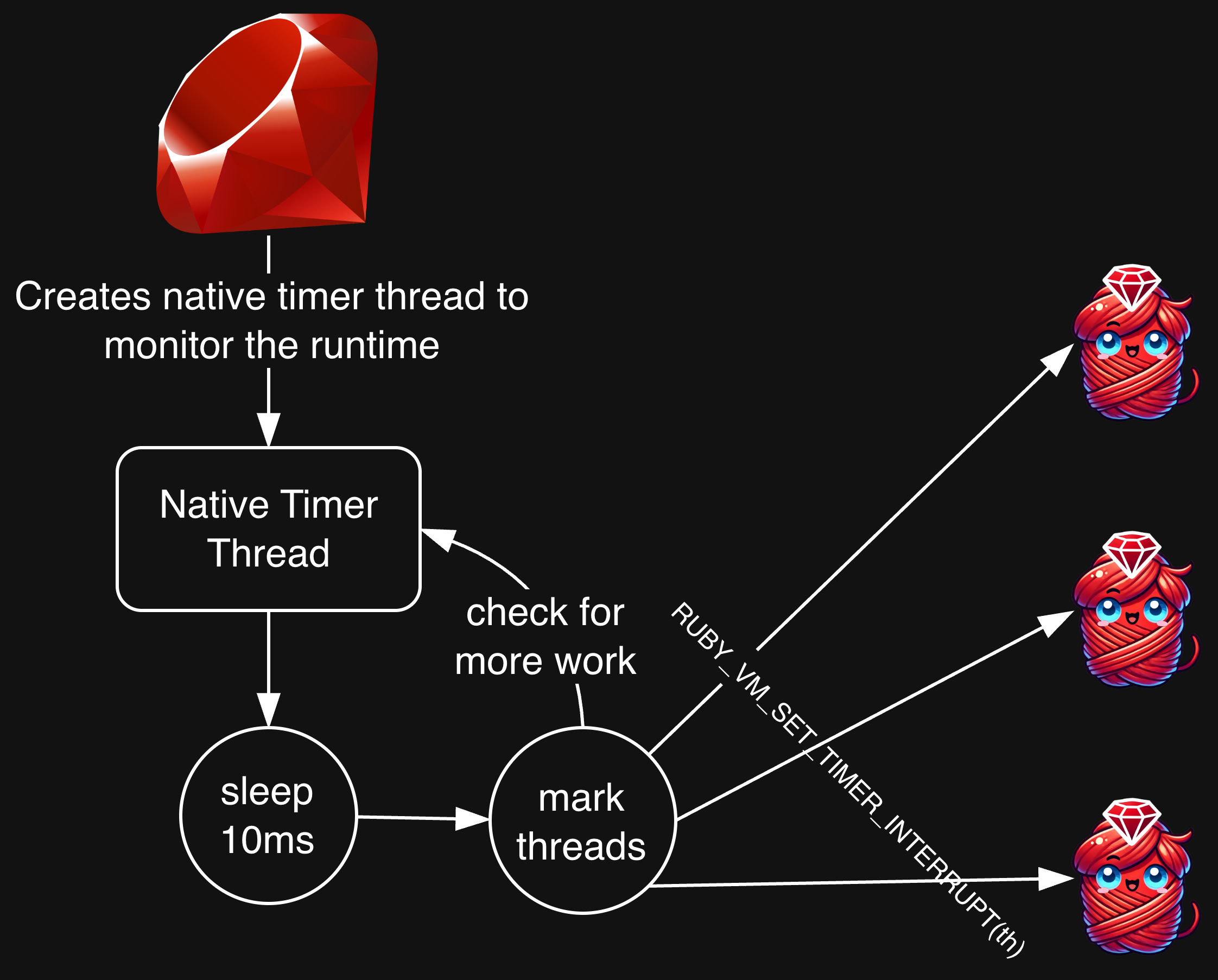
The timer interrupt is fairly straightforward:
- Get the current “quantum” (the CRuby name for the amount of time each thread can run before being context switched)
- Priority is used to increase or decrease the amount of time a thread can run above or below the default
- It is assumed the thread ran 10ms before this code, so it adds 10ms to the
running_time - An event hook is fired notifying interested plugins that a thread context switch is happening
- Calls
rb_thread_schedule_limits.
if (timer_interrupt) {
uint32_t limits_us = thread_default_quantum_ms * 1000;
if (th->priority > 0)
limits_us <<= th->priority;
else
limits_us >>= -th->priority;
if (th->status == THREAD_RUNNABLE)
th->running_time_us += 10 * 1000; // 10ms = 10_000us
EXEC_EVENT_HOOK(th->ec,
RUBY_INTERNAL_EVENT_SWITCH, th->ec->cfp->self,
0, 0, 0, Qundef);
rb_thread_schedule_limits(limits_us);
}
Since Ruby 3.4, you can set your own
thread_default_quantum_msusing the env variableRUBY_THREAD_TIMESLICE. This means the long-held CRuby constant of 100ms time slices is now adjustable, and folks have been adjusting it to handle different CPU saturated workloads.
rb_thread_schedule_limits checks if the thread is over its allotted running time, and yields if so:
static void
rb_thread_schedule_limits(uint32_t limits_us)
{
rb_thread_t *th = GET_THREAD();
if (th->running_time_us >= limits_us) {
thread_sched_yield(TH_SCHED(th), th);
rb_ractor_thread_switch(th->ractor, th, true);
}
}
We’ve discussed bit manipulation quite a bit - feels negligent to not briefly discuss that right and left bit shift for priority 🤷🏻♂️.
if (th->priority > 0)
limits_us <<= th->priority;
else
limits_us >>= -th->priority;
If th->priority is greater than zero, we shift every bit left. If not, it negates the priority (so negative priorities turn positive) and shifts every bit right. We can demonstrate how this would work easily in Ruby, using milliseconds (ms) instead of microseconds (us) for simplicity:
def calculate_priority(priority, limit)
priority > 0 ? limit << priority : limit >> -priority
end
calculate_priority(0, 100) # => 100
calculate_priority(2, 100) # => 400
calculate_priority(-2, 100) # => 25
to_b(100) # => 01100100 = 100
to_b(calculate_priority(0, 100)) # => 01100100 = 100
to_b(calculate_priority(2, 100)) # => 110010000 = 400
to_b(calculate_priority(-2, 100)) # => 00011001 = 25
# 01100100 01100100
# << 2 >> 2
# 110010000 00011001
That means that at the default quantum of 100ms, if you give a CRuby thread a priority of 2, it will be given 400ms of runtime before being forced to switch! And -2 means your thread will only run for 25ms at a time. When we shift right, we lose bits, which is why the value is lower.
`TRAP_INTERRUPT_MASK`
Now we’re onto signal handling using TRAP_INTERRUPT_MASK. The first part is what you might expect from a “trap” interrupt - signal handling. According to this code - you’ll only ever run trap handlers on the main thread. If there is a trap mask and we aren’t on the main thread, we ignore it:
/* signal handling */
if (th == th->vm->ractor.main_thread) {
// ...
}
The thread in this Ruby example will always equal Thread#main:
trap("INT") do
puts "hello from #{Thread.current}: #{Thread.current == Thread.main}"
# => hello from #<Thread:0x000000010445b2a8 run>: true
end
Next we iterate through each available signal. If multiple signals have not been processed, we process them all here. rb_signal_exec internally calls signal_exec, which we looked at earlier:
while ((sig = rb_get_next_signal()) != 0) {
ret |= rb_signal_exec(th, sig);
}
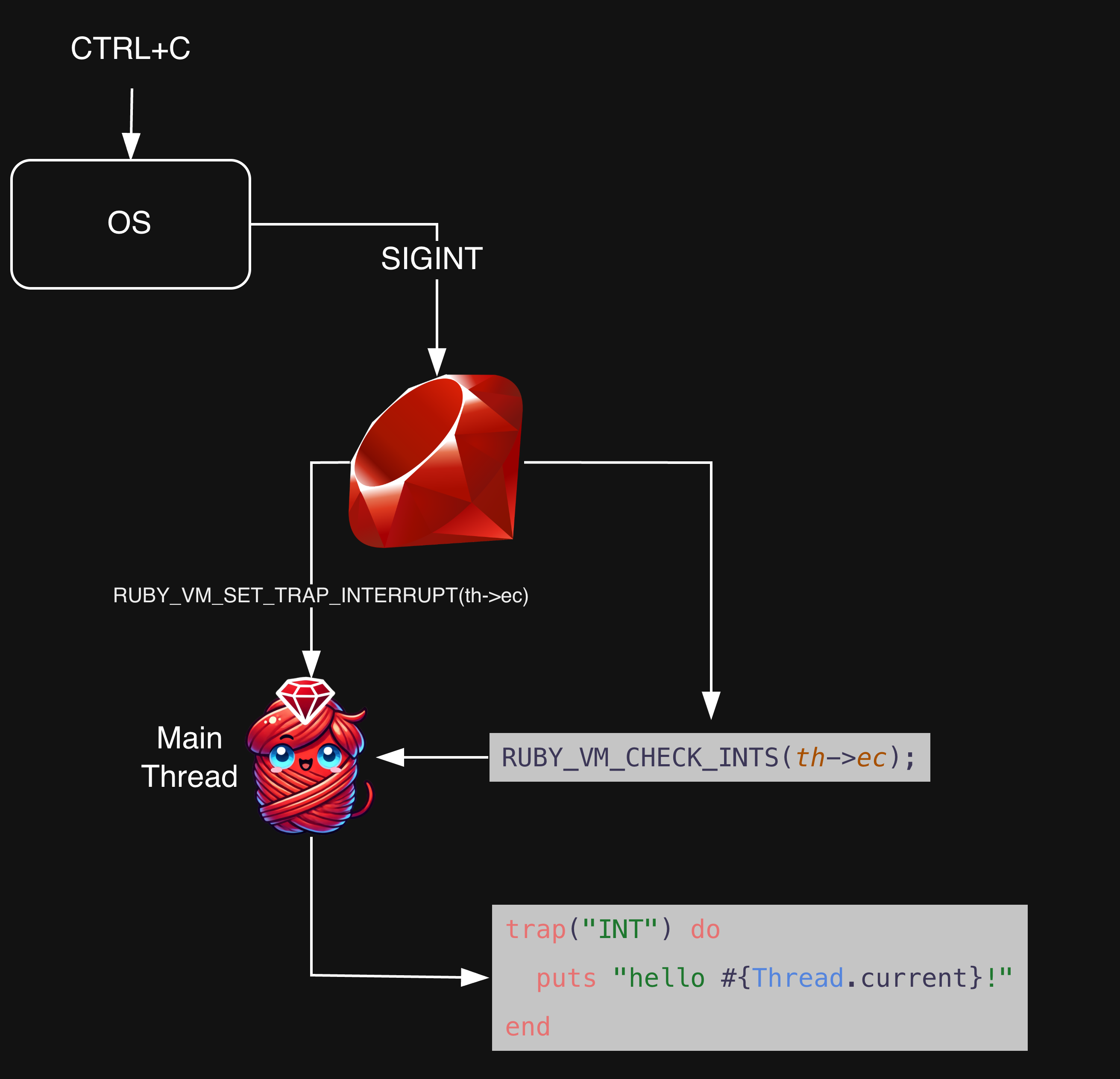
Prior to Ruby 3.4, that was the exclusive purpose of TRAP_INTERRUPT_MASK. Ruby 3.4+ also uses it to alert other threads that there is work for them to execute. You put work into the threads interrupt_exec_tasks list, and call threadptr_interrupt_exec_exec on each thread:
if (!ccan_list_empty(&th->interrupt_exec_tasks)) {
// ...
threadptr_interrupt_exec_exec(th);
// ...
}
threadptr_interrupt_exec_exec runs the requested task (a function), either in a new thread, or inline:
if (task->flags & rb_interrupt_exec_flag_new_thread) {
rb_thread_create(task->func, task->data);
}
else {
(*task->func)(task->data);
}
Seems generally handy, but was introduced for a specific purpose: supporting require and autoload inside of Ractors:
# Ruby < 3.3
Ractor.new { pp "hey there!" } # autoloads `pp`
# => `require': can not access non-shareable objects in constant Kernel::RUBYGEMS_ACTIVATION_MONITOR by non-main ractor. (Ractor::IsolationError)
Ractor.new {
require "json"
puts JSON.parse('"hey there!"')
}
# => `require': can not access non-shareable objects in constant Kernel::RUBYGEMS_ACTIVATION_MONITOR by non-main ractor. (Ractor::IsolationError)
# Ruby >= 3.4
Ractor.new { pp "hey there!" }
# => "hey there!"
Ractor.new {
require "json"
puts JSON.parse('"hey there!"')
}
# => hey there!
Requiring a gem requires accessing non-shareable objects - Ractors cannot access any state that is non-shareable. The only Ractor with access to these non-shareable objects is the main Ractor, Ractor.main. To get around this, non-main Ractors add a task to the interrupt_exec_tasks list on the main Ractor thread, and set TRAP_INTERRUPT_MASK:
rb_ractor_t *main_r = GET_VM()->ractor.main_ractor;
// for `require` calls
rb_ractor_interrupt_exec(main_r, ractor_require_func...)
// for autoloading, like when calling `pp`
rb_ractor_interrupt_exec(main_r, ractor_autoload_load_func...)
// ...
// ractor_require_func/ractor_autoload_load_func are
// referenced in task->node
ccan_list_add_tail(&th->interrupt_exec_tasks, &task->node);
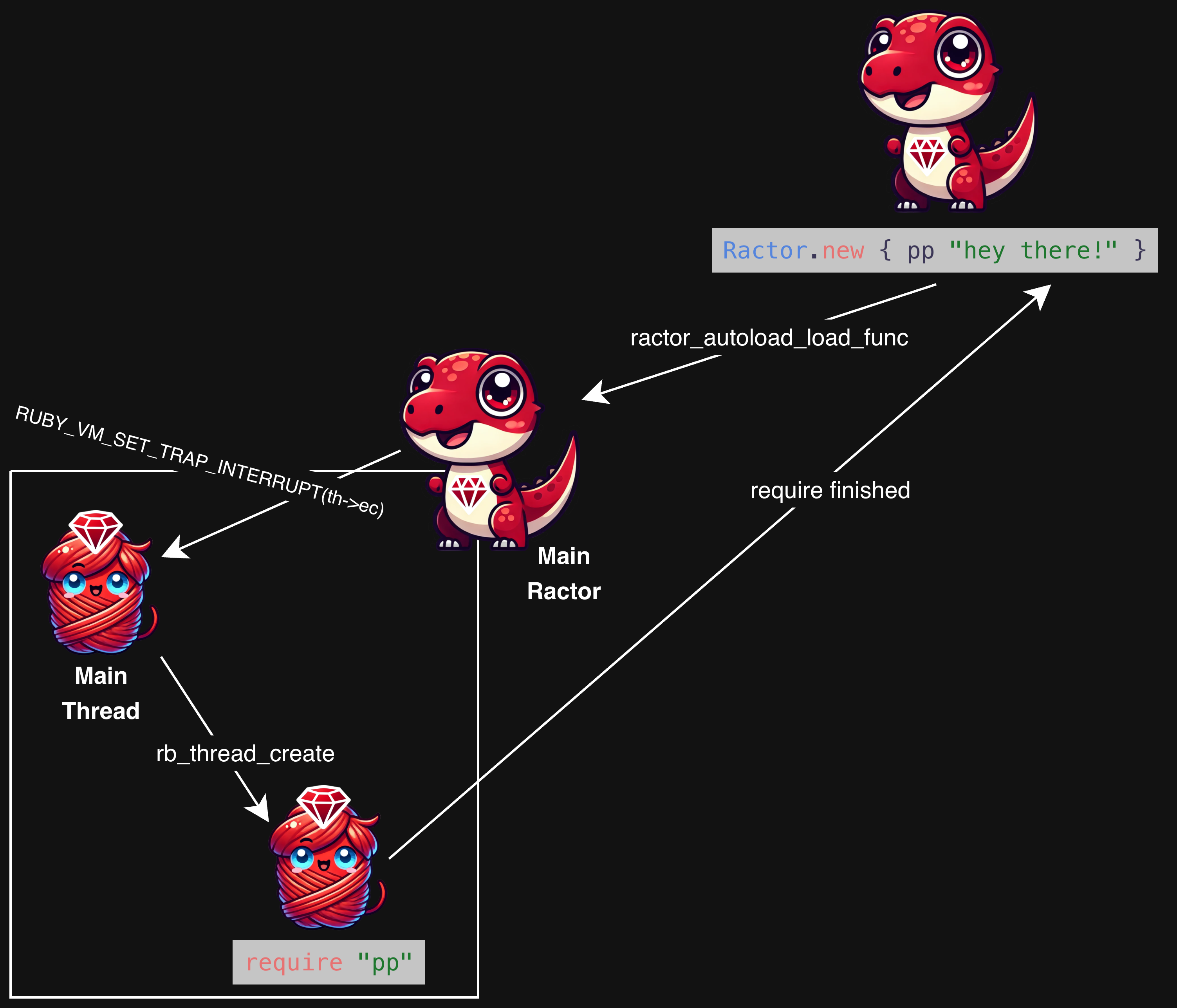
`PENDING_INTERRUPT_MASK`
Now we’ve got the heavy-hitter of thread interrupts - PENDING_INTERRUPT_MASK. It’s not clear from the name, but this mask gets set by Thread#raise and Thread#kill. It doesn’t get much more interruptive than arbitrarily raising an error within, or killing a thread.
The reason it’s called PENDING_INTERRUPT_MASK is because it indicates there are errors waiting to be evaluated in the threads pending_interrupt_queue. Every thread has a pending_interrupt_queue, and it manages the interrupts that have been enqueued by calls like Thread#raise and Thread#kill. Sometimes those interrupts are actual error instances (Thread#raise), and sometimes they are integer flags (Thread#kill).
We start off by checking if there are any active pending interrupts in the queue. If there are, we dequeue the first available interrupt. The blocking_timing relates to the #handle_interrupt method, and we’ll dig into those next time in “When good threads go bad”. For now, just know it gives you the ability to defer the thread being interrupted:
/* exception from another thread */
if (pending_interrupt && threadptr_pending_interrupt_active_p(th)) {
VALUE err = rb_threadptr_pending_interrupt_deque(th, blocking_timing ? INTERRUPT_ON_BLOCKING : INTERRUPT_NONE);
// ...
}
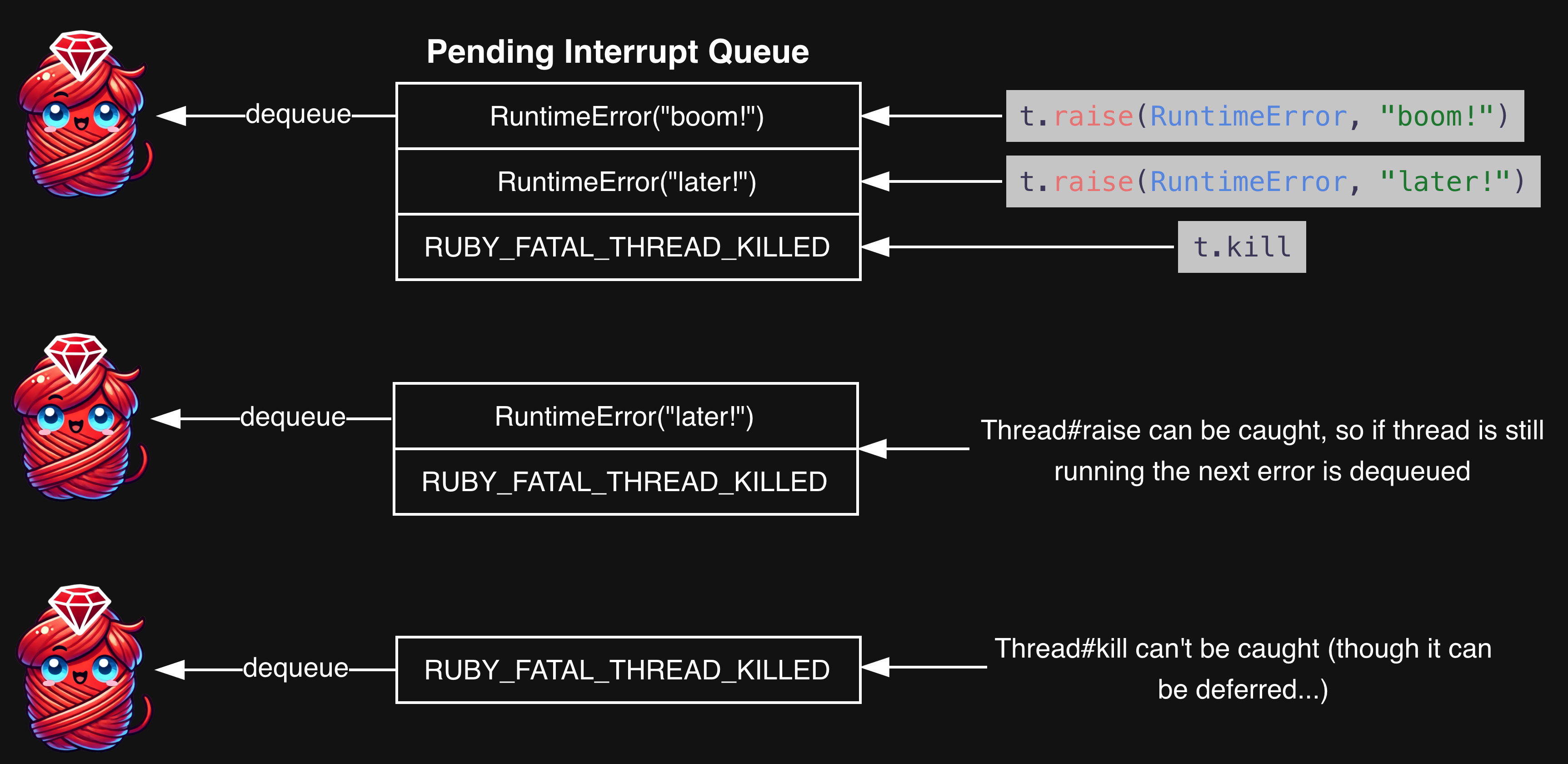
We check if the dequeued interrupt is one of the flags set by Thread#kill/Thread#terminate/Thread#exit, all representing that the thread should be killed immediately. We set the terminate_interrupt, which later in the function triggers rb_threadptr_to_kill. This kills the thread and cannot be rescued:
if (/* Thread#kill received */
err == RUBY_FATAL_THREAD_KILLED ||
/* Terminate thread */
err == RUBY_FATAL_THREAD_TERMINATED ||
/* Thread.exit etc. */
err == INT2FIX(TAG_FATAL)) {
terminate_interrupt = 1;
}
// ...
// outside of the pending interrupt if statement
if (terminate_interrupt) {
rb_threadptr_to_kill(th);
}
If the error isn’t one of the Thread#kill flags, it must be an actual Ruby exception. We make sure the thread is in a running state. Then we force it to raise an error at whatever point in the code it goes to execute next. This raises whatever error we set with Thread#raise:
/* set runnable if th was slept. */
if (th->status == THREAD_STOPPED ||
th->status == THREAD_STOPPED_FOREVER)
th->status = THREAD_RUNNABLE;
rb_exc_raise(err);
Personally, I was surprised to find that these interrupts are stored in a queue! Can we try to prove it in our Ruby code? Let’s try:
CatchyError = Class.new(StandardError)
class ErrorCatcher
def self.===(exception)
exception.message =~ /1|2|3/
end
end
t = Thread.new do
sleep
rescue ErrorCatcher
redo
rescue CatchyError
raise
end
sleep 0.1
t.raise(CatchyError.new('1'))
t.raise(CatchyError.new('2'))
t.raise(CatchyError.new('3'))
t.raise(CatchyError.new('4'))
t.join
# => #<Thread:0x0000000120961420 (irb):84 run> terminated with exception (report_on_exception is true):
# in 'Kernel#sleep': 4 (CatchyError)
In the above code:
- We setup a dynamic error matcher so we can raise the same error, but catch it differently depending on the message12
- We
rescueandredoif we get aCatchyErrorwith1,2, or3as the message - Even though we
t.raisefour times, only the fourthCatchyErroris raised. If you change the regex to match/1|2/, it will fail on the third error instead - It really is running through the queue of errors!
`TERMINATE_INTERRUPT_MASK`
TERMINATE_INTERRUPT_MASK is pretty niche. You’ll remember this code from the Thread#kill code earlier triggered by the pending_interrupt_queue:
if (terminate_interrupt) {
rb_threadptr_to_kill(th);
}
There are two ways to trigger that code:
- Using
Thread#kill, as we already learned - When a Ruby process is shutting down. As part of that shutdown, all Ractors are terminated, which set
TERMINATE_INTERRUPT_MASKon each of their threads
`POSTPONED_JOB_INTERRUPT_MASK`
Still in the niche-zone, we’ve got POSTPONED_JOB_INTERRUPT_MASK.
This mask is used when work needs to be performed, but can’t safely run in its current context. By making it an interrupt mask, the work can be inserted into a safe point for execution in the CRuby runtime:
if (postponed_job_interrupt) {
rb_postponed_job_flush(th->vm);
}
The rb_postponed_job_flush function iterates through work in the postponed_job_queue, calling each function in the queue.
In CRuby, I can only find references to it in the Tracepoint source code. In concept, it seems very similar to the interrupt_exec_tasks used for Ractor#require. I’m sure there is a CRuby committer who could explain this further - I’d be curious to understand it better!
`VM_BARRIER_INTERRUPT_MASK`
Not to be outdone by TERMINATE_INTERRUPT_MASK and POSTPONED_JOB_INTERRUPT_MASK, we’ve got king-niche: VM_BARRIER_INTERRUPT_MASK. When set, it runs RB_VM_LOCKING() on the thread:
if (interrupt & VM_BARRIER_INTERRUPT_MASK) {
RB_VM_LOCKING();
}
It’s niche, but seems to play an important role in giving the entire VM exclusive access to an operation. This appears to have been introduced with Ractors in Ruby 3. That makes sense - Ractors are the first truly parallel unit of execution in Ruby.
Certain operations, like YJIT compiling bytecode, require exclusive access to the VM when running. For instance, when rb_yjit_compile_iseq is called, the first thing it does is call rb_vm_barrier:
void
rb_yjit_compile_iseq(const rb_iseq_t *iseq, rb_execution_context_t *ec, bool jit_exception)
{
RB_VM_LOCKING() {
rb_vm_barrier();
rb_vm_barrier sets the VM_BARRIER_INTERRUPT_MASK on all running threads across Ractors, then waits for each to stop at the barrier:
// interrupts all running threads
rb_thread_t *ith;
ccan_list_for_each(&vm->ractor.sched.running_threads, ith, sched.node.running_threads) {
if (ith->ractor != cr) {
RUBY_VM_SET_VM_BARRIER_INTERRUPT(ith->ec);
}
}
// wait for other ractors
while (!ractor_sched_barrier_completed_p(vm)) {
ractor_sched_set_unlocked(vm, cr);
rb_native_cond_wait(&vm->ractor.sched.barrier_complete_cond, &vm->ractor.sched.lock);
ractor_sched_set_locked(vm, cr);
}
———
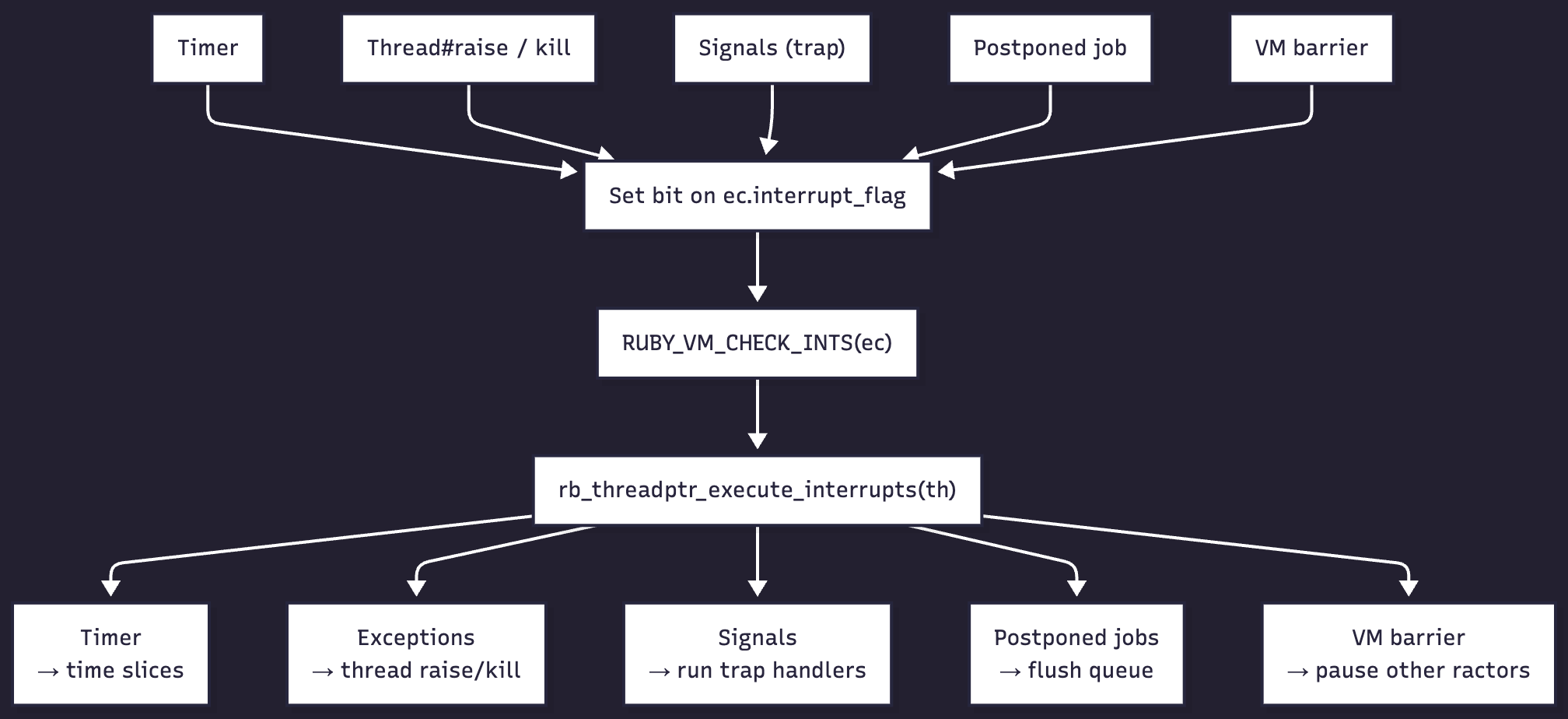
😮💨 We dug deep in this one. Bitmasks, CRuby internals, Thread management - what could be next? With all this knowledge, we’re primed and ready to dig into what to do when a thread goes rogue. See you next time in “When good threads go bad” 👋🏼
-
With Aaron Patterson’s PR to have a configurable quantum, this can be configured now. But whatever it’s set to is still static during a programs execution, and still defaults to 100ms ↩︎
-
https://jpcamara.com/2024/06/04/your-ruby-programs.html#heisenbugs ↩︎
-
It can still happen, but it’s less likely. We’ll discuss ways it can happen later in the series ↩︎
-
JRuby does as well! https://github.com/jruby/jruby/blob/master/core/src/main/java/org/jruby/RubyThread.java#L822 ↩︎
-
The different number syntaxes in Ruby (binary, octal, decimal, hex) are really just sugar on the Integer class. So when you run these code snippets you’ll actually see a decimal integer rather than the binary I show in the comment ↩︎
-
If you don’t want to use a
whileloop, there’s a great alternative here: https://bsky.app/profile/jpcamara.com/post/3m2ntcgzhe22c ↩︎ -
1,001,102, to be exact
See https://jpcamara.com/2024/11/28/counting-c-method.html for how I got that number ↩︎
-
If we simplified the loop to be
while(true); end, we’d actually exclusively use thejumpinstruction: https://redgetan.cc/understanding-timeouts-in-cruby/#6-working-examples ↩︎ -
But interesting way to think about an if statement! ↩︎
-
Fun fact - if you run this example with YJIT it goes back down to five hundred thousand. YJIT seems to inline the method call and that bypasses the ints check ↩︎
-
This particular check is technically linux/unix specific. On Windows,
thread_win32.cis used and it maintains its own timer thread and priority controls specific to Windows. ↩︎ -
Thanks to the Honeybadger blog for the tip on dynamic exception matchers!
https://www.honeybadger.io/blog/level-up-ruby-rescue-with-dynamic-exception-matchers/ ↩︎